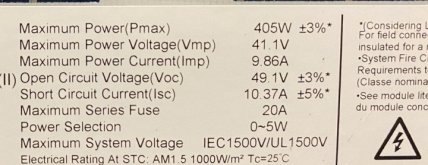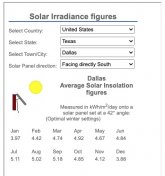Vertex Ranch
New Member
- Joined
- Feb 19, 2021
- Messages
- 5
There is a local company that has several hundred of these panels. I'd like to set up a new system (the one I have currently is just a backup system for a Decoupled Aquaponics system to sustain the air supply to the fish tank should the electricity go out).
These panels are VERY high output, check the label I've attached.
So, the question is.. would you Solar Gurus/Pros buy used commercial panels? They WILL let me test them before I buy and if they fail after I install them they'll swap them out.
They're asking $180 per panel. IF the panels prove to be of good quality, this would be a great way for us to build a large system affordably.
My NEXT question is, what controller would you recommend for a medium-sized 4kW system?
Is there any value in setting up TWO 2kW systems, one for primary loads (fridge, fans, lights, fridge, etc.) and another for secondary systems (outdoor lights, modem/router. etc) over ONE 4kW system?
I appreciate all the education and advice you're willing to offer.. I'm learning quickly about solar systems and how to setup them up, but I know I have A LOT to learn when it comes to designing them and selecting components.
Thanks in advance and great work setting up a thriving, informative community.
Jesse
These panels are VERY high output, check the label I've attached.
So, the question is.. would you Solar Gurus/Pros buy used commercial panels? They WILL let me test them before I buy and if they fail after I install them they'll swap them out.
They're asking $180 per panel. IF the panels prove to be of good quality, this would be a great way for us to build a large system affordably.
My NEXT question is, what controller would you recommend for a medium-sized 4kW system?
Is there any value in setting up TWO 2kW systems, one for primary loads (fridge, fans, lights, fridge, etc.) and another for secondary systems (outdoor lights, modem/router. etc) over ONE 4kW system?
I appreciate all the education and advice you're willing to offer.. I'm learning quickly about solar systems and how to setup them up, but I know I have A LOT to learn when it comes to designing them and selecting components.
Thanks in advance and great work setting up a thriving, informative community.
Jesse




